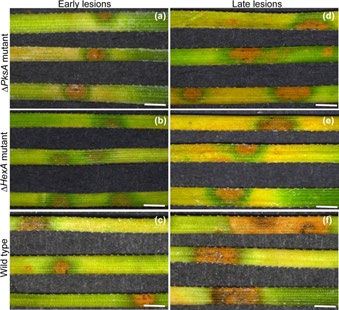PESTS AND DISEASES OF FORESTRY IN NEW ZEALAND
Dothistromin toxic in a virulence factor in dothistroma needle blight of pines
Scion is the leading provider of forest-related knowledge in New Zealand
Formerly known as the Forest Research Institute, Scion has been a leader in research relating to forest health for over 50 years. The Rotorua-based Crown Research Institute continues to provide science that will protect all forests from damage caused by insect pests, pathogens and weeds. The information presented below arises from these research activities.
From Forest Health News 250 , September 2014.
Dothistroma needle blight is a problem in many forests in New Zealand. A characteristic feature of this disease is the presence of a red band, earning it the alternative name of ‘red band’ disease. Ever since Bassett and others determined that the red colour is largely due to dothistromin, a toxin produced by the pathogen, scientists have wondered what role, if any, dothistromin has in the disease.

In early studies by Robert Franich and co-workers, injection of purified dothistromin into pine needles was shown to elicit host cell death and a defence response in the form of benzoic acid production. But Schwelm and others then showed that mutants of the Dothistroma septosporum fungus that no longer make the toxin are still able to cause the disease.
M. Shahjahan Kabir, a Ph.D. student from Massey University studied the interaction between dothistromin- deficient mutants of the pathogen and Pinus radiata in detail using modern microscopy and biochemical techniques. He confirmed that the ability to make dothistromin is not needed for the fungus to cause disease, but found that dothistromin does affect the symptom severity. Without dothistromin, the pathogen colonised a smaller area of the needle, produced significantly smaller lesions (Figure 1) and, importantly, produced less than 4% of the number of spores per lesion, compared to normal dothistromin-producing strains of the pathogen. This showed that dothistromin is a virulence factor that not only increases symptoms but also inoculum production, and confirms the hypothesis proposed by Peter Gadgil in 1967 that dothistroma needle blight involves an exotoxin.
Kabir also showed that dothistromin is mainly produced after some needle tissue has already been killed, which is when the fungus is starting to get established and grow through the needle. The combined team at Massey University and Scion are working to determine what kills the needle tissue, as this may hold the key to identifying hosts resistant to dothistroma needle blight.
Kabir’s work was funded by the Bio-Protection Research Centre and a Massey Doctoral Scholarship. He was co- supervised by Associate Professor Rosie Bradshaw, Massey University and Dr Beccy Ganley, Scion. His work has been published in the journal Plant Pathology.
Shahjahan Kabir, Beccy Ganley and Rosie Bradshaw
Kabir, S., Ganley R.J., and Bradshaw, R.E. (2014) Dothistromin toxin is a virulence factor in dothistroma needle blight of pines. Plant Pathology (available on-line) Doi: 10.1111/ppa.12229
This information is intended for general interest only. It is not intended to be a substitute for specific specialist advice on any matter and should not be relied on for that purpose. Scion will not be liable for any direct, indirect, incidental, special, consequential or exemplary damages, loss of profits, or any other intangible losses that result from using the information provided on this site.
(Scion is the trading name of the New Zealand Forest Research Institute Limited.)

 Farm Forestry New Zealand
Farm Forestry New Zealand

